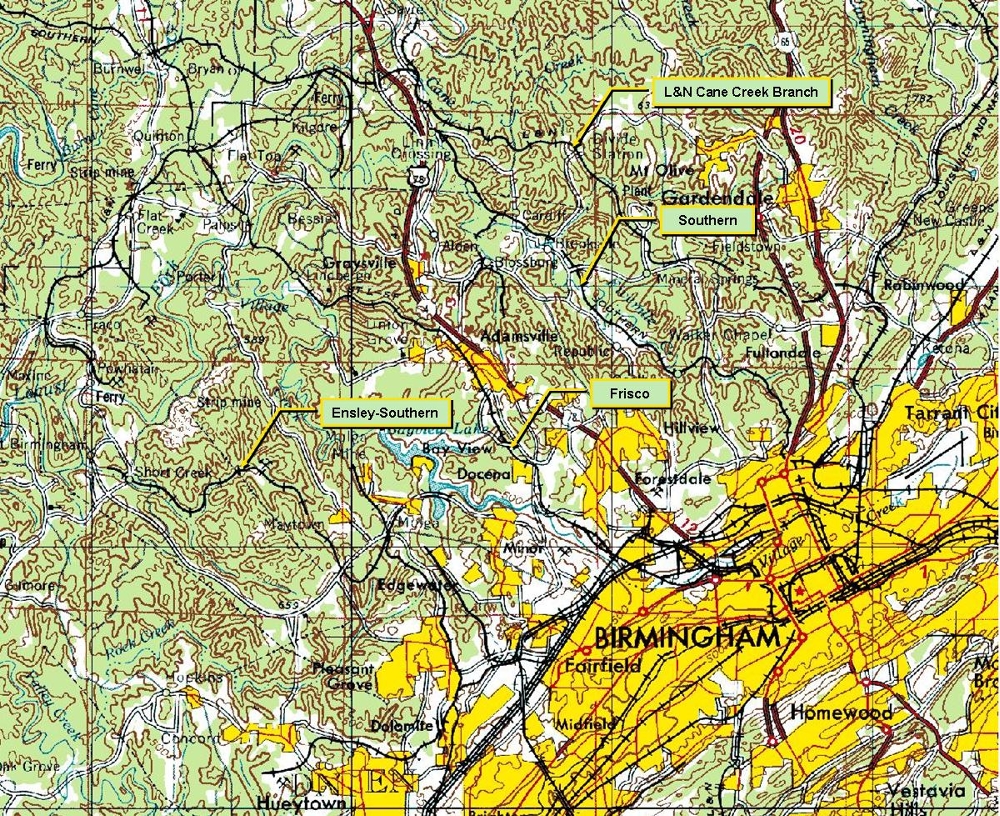L&N Cane Creek Branch
As the Birmingham District continued to develop, it became clear that there were tremendous coal resources in West Jefferson County and adjacent Walker County. The L & N did not have access to this area, and line was extended westward from the mainline at Black Creek Junction, south of Newcastle, and north of Boyles in about 1903.
But there was more going on at the time. Ron Mele's book, Birmingham Southern, The First Century, sheds light on the bigger business picture at the time. This is an interesting picture of competition and cooperation between the Southern and the L&N. It also shows that the business decisions made by the industrial leaders were not always clear, and that strategic directions could change quickly. Building railroads is not easy.
Consider that you are in the railroad business, and you note that there are extensive coal deposits in western Jefferson and eastern Walker County. There is a "corridor" or planning route, from Birmingham to the northwest toward Memphis. The northern side of this corridor is in northern Jefferson County, running southeast to northwest. The southern side of this corridor is on the southern side of Jefferson County.
In the early 1880's, the Southern's predecessor, ETV&G considered accessing western Jefferson and eastern Walker County. Their route would have been the southern side of the corridor, through Port Birmingham, to connect to lines from the northwest. Thus the Ensley Southern was incorporated in February, 1900.
The L&N, on the other hand is reported to have considered a line on the northern side of the corridor to the coal fields. They considered a line from Phelans, south of Cullman, AL, on the main line between Decatur and Birmingham. This seems to make sense, since it follows the terrain better. The L&N plan would have connected to the Birmingham Mineral RR at Ensley apparently curving along the county line and then swinging to the southeast, back toward a connection in Ensley. Any route on a southeast to northwest path would fight the ridges and valleys unless a watercourse could be followed. Thus the North Alabama RR Co. (not Northern Alabama) was incorporated by L&N in the spring of 1900.
Mele summarizes that the two companies realized that they could end up with parallel routes, (apparently in southwest Jefferson County) so they decided to join forces and cooperate with trackage rights rather than compete. Although the details are not clear, he indicates that an agreement was reached in May, 1900 for the Ensley Southern to build the line, with L&N to have trackage rights.
Thus, the Ensley Southern would build from the Ensley area toward Parrish, AL, in Walker County. Southern interests had a line that could be extended from Parrish to the southeast to meet the Ensley Southern. This line would cross the Warrior at what would become Port Birmingham, which was a worthwhile thing to do, as the river would be navigable to that point, opening markets to the south, such as Mobile.
Mele's account continues that the agreement between Southern and L&N, formed in spring of 1900, was dissolved in May, 1902. This left the Ensley Southern as a subsidiary of the Southern, and the L&N to build it's own line on the northern side of the corridor. The Ensley Southern became the Birmingham Southern, and the L&N went on to build the Cane Creek Branch, rather than a line originating in Cullman County.
The following map show the "big picture. Phelans is located just outside the top of this map to the north. Birmingham is easily seen in the lower left. Jasper, in Walker County marks the direction that the coal fields lie from Birmingham.
